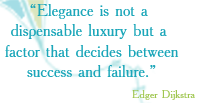Posts tagged ‘UML’
Se-Radio.net: Bran Selic on UML 2
 The Unified Modeling Language (UML) is a graphical language for visualizing, specifying and constructing the artifacts of a software-intensive system. The Unified Modeling Language offers a standard way to write a system’s blueprints, including conceptual things such as business processes and system functions as well as concrete things such as programming language statements, database schemas, and reusable software components. UML combines the best practice from data modeling concepts such as entity relationship diagrams, business modeling (work flow), object modeling and component modeling. It can be used with all processes, throughout the software development life cycle, and across different implementation technologies.
The Unified Modeling Language (UML) is a graphical language for visualizing, specifying and constructing the artifacts of a software-intensive system. The Unified Modeling Language offers a standard way to write a system’s blueprints, including conceptual things such as business processes and system functions as well as concrete things such as programming language statements, database schemas, and reusable software components. UML combines the best practice from data modeling concepts such as entity relationship diagrams, business modeling (work flow), object modeling and component modeling. It can be used with all processes, throughout the software development life cycle, and across different implementation technologies.
DUALLy
 Many architectural languages have been proposed in the last fifteen years, each one with the chief aim of becoming the ideal language for specifying software architectures. What is evident nowadays, instead, is that architectural languages are defined by stakeholder concerns. Capturing all such concerns within a single, narrowly focused notation is impossible. At the same time it is also impractical to define and use a “universal” notation, such as UML. As a result, many domain specific notations for architectural modeling have been proposed, each one focussing on a specific application domain, analysis type, or modeling environment.
Many architectural languages have been proposed in the last fifteen years, each one with the chief aim of becoming the ideal language for specifying software architectures. What is evident nowadays, instead, is that architectural languages are defined by stakeholder concerns. Capturing all such concerns within a single, narrowly focused notation is impossible. At the same time it is also impractical to define and use a “universal” notation, such as UML. As a result, many domain specific notations for architectural modeling have been proposed, each one focussing on a specific application domain, analysis type, or modeling environment.
These considerations led us to propose DUALLy a framework to create interoperability among ADLs themselves as well as UML. As conceptually shown in the figure below, DUALLy permits to transform concepts of an architectural model M1 into the semantically equivalent concepts in the architectural model M2. Each Mi conforms to its MMi meta-model or UML profile. Every MMi can be a meta-model of an architectural language. Therefore, DUALLy works at two abstraction levels: meta-modeling (upper part of the figure), and modeling (lower part of the figure).
At the meta-modeling level, model driven engineers provide a specification of the architectural language in terms of its meta-model or UML profile. They then define a meta-transformation so as to semantically relate architectural concepts in MM1 with the equivalent elements in MM2.
At the modeling level, software architects specify the SA using their preferred ADL or UML-based notation. DUALLy allows the automatic generation of model-to-model transformations which permit the software architect to automatically translate the M1 specification (written according to MM1) into the corresponding M2 model (conforming to MM2) and viceversa.
As it can be noticed in the figure above, the meta-transformation (and its corresponding generated transformation) relates MM1 to MM2 (as well as M1 to M2) passing through what we refer to as A0. A0 represents a semantic core set of modeling elements, providing the infrastructure upon which to construct semantic relations among different ADLs. It acts as a bridge among the different architectural languages to be related together.
DUALLy is automated and implemented as an Eclipse plugin. MMi meta-models are expressed in Ecore. MMi profiles can be realized using any UML tool which exports in UML2, the EMF-based implementation of the UML 2.0 meta-model for the Eclipse platform. A0 is represented as a UML profile. Transformations among meta-models/profiles and model-to-model transformations are implemented in the context of the AMMA platform. Model-to-model transformations are then automatically instantiated, thus providing the possibility to automatically reflect modifications made on a model designed with one extension to one or even all of the other extensions.
The main advantages DUALLy exposes can be summarized as follows:
- DUALLy works at two abstraction levels, providing a clear separation between model driven experts (the technical stakeholder) and software architects (the final users). The model transformation engine is completely hidden to a software architect, making DUALLy extremely easy to use.
- DUALLy permits the transformation among formal ADLs and UML model-based notations and viceversa.
- Software architects can continue using familiar architectural notations and tools, and reusing existing architectural models.
- DUALLy permits both languages and tools interoperability.
- The meta-transformations among two architectural notations are defined once, and reused for each model that will be made.
Further details on DUALLy may be found by navigating the “framework” left-menu of this site.
This work is partially supported by ARTDECO (Adaptive infRasTructure for DECentralized Organizations), an Italian FIRB (Fondo per gli Investimenti della Ricerca di Base) 2005 Project.








Recent Comments